I had been desiring to visit Gua Kota Gelanggi ever since reading a report on the hidden city of the same name in Johor. Coming from KL, the drive up to Pahang would take at least a good two hours, so we departed at the break of dawn and had breakfast at the Bentong R&R before we embarked on our journey.

It took half an hour driving up the Karak Highway before we took the Chenor Exit to get into Jengka, Pahang. From there, it was another hour’s drive up North to get to Taman Warisan Gua Kota Gelanggi.
Needless to say, anticipation was running high. A few false turns (and a detour into a FELDA residential town) raked our spirits a little, but it wasn’t long before we finally found a highway that led us to our destination.
Be careful: it’s entirely possible to miss this turning. It’s sharp turn into small hidden road downhill that leads to what looks like suspicious bushes. Take the obvious-looking road in and you’ll eventually end up to open gates, mouldy from weather.
Taman Warisan Gua Kota Gelanggi
Adults have to pay RM5 for entry, while children pay RM3. I would call that affordable in this economy. While you may want to park your car at the nearby parking lot and walk the rest of the journey, you’re allowed to drive your vehicle in, as there’s another spot for parking right at the end of the long road between the forest trees.
At least 500 metres in, you would be greeted by Gua Tongkat. This open cave structure is arresting with it’s centuries-long stalactites formation. If you inspect it closely, you could tell the weathered years the rocks endured and where the constant dripping of water has ate away. What’s wondrous to me is that it’s an open cave. At one point of time, it could have possibly been closed but geological shifts would have probably given way.
If you’re interested in camping here, there are camping grounds around the corner. In my exploration, I chanced upon the remains of a charred fireplace, some traces of waste and a levelled ground from constant wear. But Gua Tongkat is only the beginning, walk in further and you’ll see more.
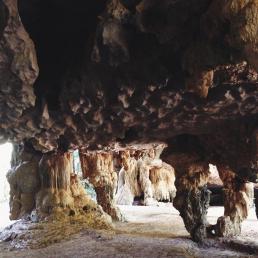
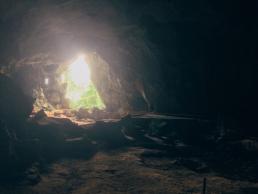
Depending on whether you drive or walk, your journey to Gua Balai, can range from 10 minutes to an hour. Apart from Gua Terang Bulan and Gua Tongkat (encountered earlier), these are the only three accessible caves within the reach of the main road. The others require trekking, which will require the guidance of the Ranger. A trekking session costs RM200 flat and I’d suggest bringing together a large group if you’re into exploring more than just three caves.
“Kota Balai mengikut ceritanya adalah sebagai tempat orang Bunian mengadakan upacara-upacara, jamuan dan sebagainya.”
— Hamzah Mohamed
Once inside Gua Balai, you’re faced with a space of at least two football fields. In reflecting on the the cave, you could tell that the vast space once housed a community, some many thousands of years ago. It’s lighted only by natural light coming from cave openings. In the morning and afternoon, this light would be sufficient in exploring the general space of the cave. Though I would hasten to add: a strong torchlight would be highly invaluable. If you’re the sort to be gripped by natural curiosity, you will no doubt be attracted to several areas of the cave that begs for exploration. This would require a little more than just grit and a directed torch-beam.
Though parts of the cave can be scaled with only one’s hands and foot, the more challenging parts (such as towards the end of the cave, upwards) you would benefit from a climbing rope that is conveniently prepared from previous expeditions. The climb up can be daunting, especially if you’re not the physical type but the adrenaline gratification can be rewarding – until you realise you have to scale back down. Believe me when I say that climbing down is much more difficult than climbing up. Especially when you’re navigating in the dark, despite your eyes most likely have adapted to what little sunlight is left.
I must stress here that in entering these caves, it’s very important that you inform the Ranger stationed at the entry of the park. In the long hours we spent exploring the cave, there was not one soul in sight or sound. Should anything fatal had happened, it’s likely that we wouldn’t have been found until many weeks or months later – given the dark and crevice-like nature of the caves. Safety first.
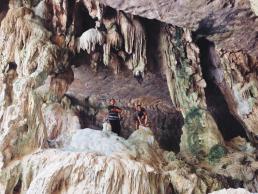
After our hours-long exploration in Taman Warisan Gua Kota Gelanggi, we left for Jerantut, the nearby town. After a good deal of searching, we managed to find a food court that sold Tempoyak Ikan Patin, a local delicacy. Ikan patin is a type of freshwater catfish and like those of its species, the flesh is soft with a small number of fine bones – those, you may want to pick out. Being in Pahang, you may want to sample it tempoyak-style where the fish is cooked with durian flesh. It leaves a strong tangy taste (if you’re into that sort of thing) and makes for quite a delicious experience.
After lunch, we continued our search for the elusive Sungai Rengat that was apparently only frequented by locals. The following two-hour journey to find the river proved it right on all points.
Sungai Rengat
Sungai Rengat is impossible to find on the map. Don’t expect your GPS or phone-map application to have it nailed down. This one’s off the grid – which makes the search for it even more challenging. From Jerantut town, we were given a rough line heading towards Kuala Lipis. Though even with an idea, we got lost plenty of times and reverted to the tried and tested way of travelling: asking for directions from the locals.
Eventually after some hours of tense turns and detours, we found an unassuming signboard labelled Sungai Rengat in faded green letters. In the advice of a local trader, “Nampak tanah merah, masuk terus”. Little did we anticipate the great challenge ahead of us.
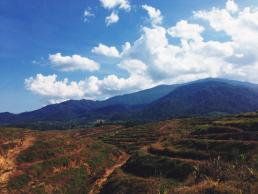
The road to Sungai Rengat is paved with sharp rocks and gravel, and is unkind to anything but a 4×4 drive. Since we were travelling in a sedan, the last thing we wanted was to have the tyres burst. We ended up driving at 10km/hour while local motorcycles and jeeps whizzed past us, leaving a choking trail of dust.
Further in, we passed by a settlement where the indigenous people lived at the borders of a palm oil plantation. We gathered that they were workers at the plantation, employed by FELCRA, who also established a tangible (modern) community for them with basic amenities as compensation. It does bring up the question of modernisation: should we be imposing values and infrastructure alien to these communities? On the way in, you could not miss a sign saying that there is a religious centre down the road, no doubt to service these indigenous communities who did not have Islam as their original faith system.
Imposition isn’t anything new. Such as when the Western colonists came to parts of Asia and established a new system of administration and culture alien to the locals. Ironic how we seem to dictate values. Though also equally alarming is the fact that these indigenous communities are a fixed voting bank for the ruling government who offer them these amenities and wouldn’t know any better.
Anyway, we drove past the winding roads of the oil palm plantation. Set against the warm evening sun, it was a sight to behold, with the hills dwindling away in the horizon. We had been driving for forty-five minutes and still no sign, sight or sound of the river. Locals we met on the way in kept on saying the same thing: “dalam lagi”. Though one could wonder: just how further in?
It wasn’t long before we faced an uphill road, scarred by logging and deforestation, did we stop and park our car to the side. We heard the sound of roaring water coming from inside the jungles and decided to walk our way in. On our left though, was an upsetting reality of a bald hill, with fell trees and stumps. It is occurrences like these that lead to flash floods, when there is no strong vegetation to prevent loose soil from eroding and causing destruction. What happened in Kelantan at the end of last year was a due to uncontrolled logging such as this.
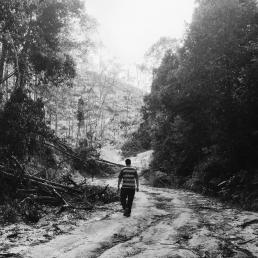
We walked in a small path downhill, following the sound of roaring water and indistinct laughter. At the foothill, we met smiling locals, who were swimming in the pristine river. The water colour dragged from sandy yellow to deep blue, clear and refreshing. A bit further up, a few young men had already started a fire, ready to cook a fish they had caught from the river. As for me and my friends, we jumped straight into the river. The hour-long drive in was worth it and the reward was a river untouched by city slickers – we were likely the few who did.
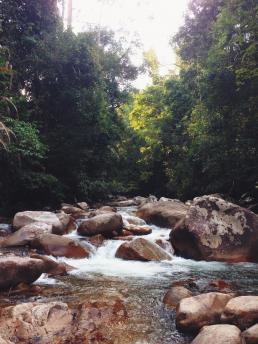
Recommended Reading:
- Kota Gelanggi Penuh Misteri – Memoirku: Guru Sebenar Guru